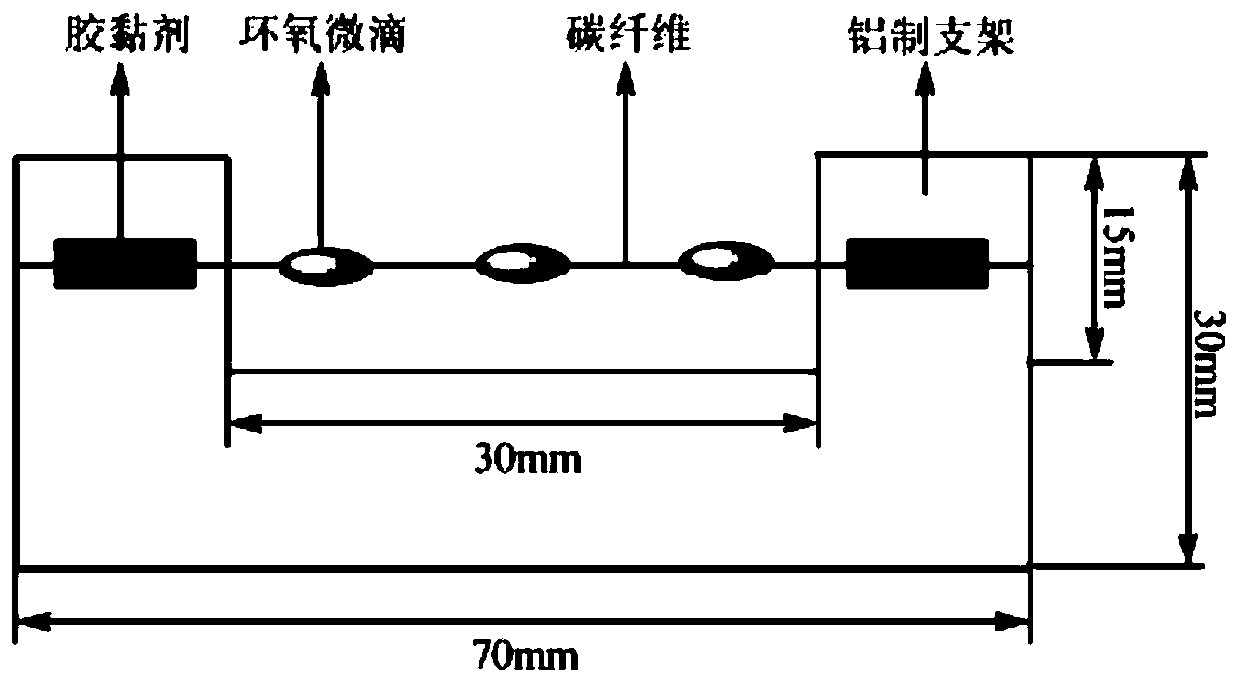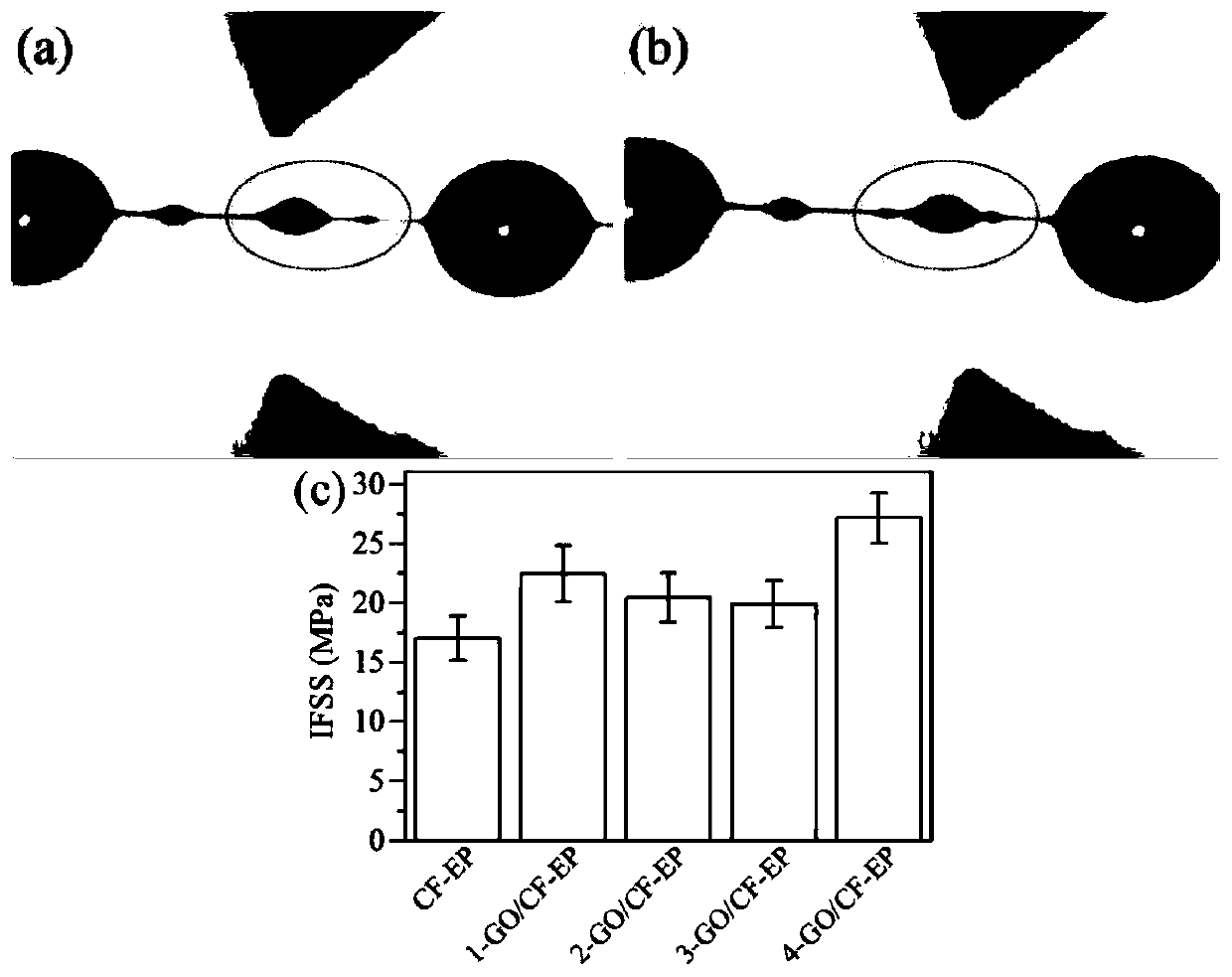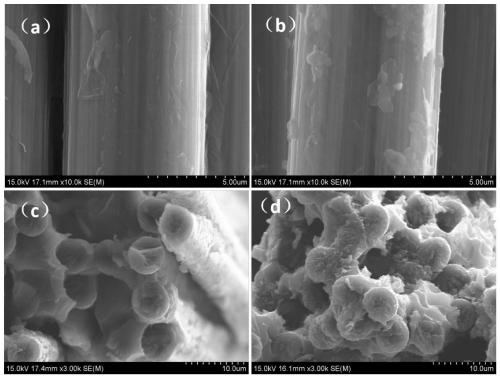A preparation method of graphene oxide modified carbon fiber initiated by silane coupling agent-assisted electrophoretic deposition
A silane coupling agent, electrophoretic deposition technology, used in carbon fiber, fiber processing, textiles and papermaking, etc., can solve problems such as increasing the contact area between carbon fiber and resin, reducing the interface properties of composite materials, and adversely affecting the mechanical properties of reinforcements, and achieves improvement. Effects of interfacial shear strength, shortening modification time, increasing reactive sites and effective contact area
- Summary
- Abstract
- Description
- Claims
- Application Information
AI Technical Summary
Problems solved by technology
Method used
Image
Examples
preparation example Construction
[0038] This application provides a method for preparing graphene oxide. Graphene powder, sodium nitrate, concentrated sulfuric acid, and potassium permanganate are mixed and reacted in an ice water bath to obtain mixture A. The mixture A is heated to 35±5°C and reacted for a period of time. Add water, and then increase the temperature to 98±5°C to obtain the mixture B after the reaction. The mixture B is diluted with water and then added with hydrogen peroxide solution for reaction, filtered, washed, and dried to obtain graphene oxide.
[0039] More preferably, the ratio of concentrated sulfuric acid to sodium nitrate is 180:2.5, mL:g, and the mass ratio of graphite powder, sodium nitrate and potassium permanganate is 2:1:6.
[0040] Further preferably, the reaction temperature for obtaining the mixture A is 2±0.5° C., and the reaction time is 1 h.
[0041] More preferably, the reaction time for heating to 35±5°C is 30±5 min, and the reaction time for heating to 98±5°C is 15±5 min.
...
Embodiment 1
[0050] (l) Put the carbon fiber in an acetone solution, react for 24 hours at a constant temperature of 70°C, alternately wash several times with absolute ethanol and deionized water, and then dry the washed carbon fiber at 80°C to a constant weight. Prepare 1% by mass aminopropyltriethoxysilane (APTES) and 0.5% by mass ethanol aqueous solution, hydrolyze at room temperature for 2h, put the dried carbon fiber into the above mixed solution, ultrasonic treatment at 60℃ for 30min, deionize After repeated washing with water and drying treatment at 80°C, the carbon fiber pretreated by the silane coupling agent is obtained to a constant weight.
[0051] (2) Add graphene oxide to deionized water, and ultrasonically treat it for 20 minutes to obtain a graphene oxide aqueous solution with a concentration of 0.03 mg / mL, and adjust the pH value of the deposition solution to pH=10 with potassium hydroxide.
[0052] (3) The graphene oxide aqueous solution obtained in step (2) is added to the el...
Embodiment 2
[0054] (1) Put the carbon fiber in an acetone solution, react for 24 hours at a constant temperature of 70°C, wash it several times with anhydrous ethanol and deionized water alternately, and then dry the washed carbon fiber at 80°C to a constant weight. Prepare an aqueous solution of 2% by mass aminopropyltriethoxysilane (APTES) and 0.5% by mass ethanol, hydrolyze at room temperature for 3 hours, put the dried carbon fiber into the mixed solution, ultrasonically treat at 60°C for 40 minutes, and deionize After repeated washing with water and drying at 80°C, the carbon fiber pretreated with silane coupling agent to a constant weight is obtained. The surface morphology of the obtained carbon fiber is as figure 2 Shown.
[0055] (2) Add graphene oxide to deionized water, and ultrasonically treat it for 30 minutes to obtain a graphene oxide aqueous solution with a concentration of 0.04 mg / mL, and adjust the pH of the deposition solution to pH=9 with potassium hydroxide.
[0056] (3) ...
PUM
| Property | Measurement | Unit |
|---|---|---|
| thickness | aaaaa | aaaaa |
| strength | aaaaa | aaaaa |
| diameter | aaaaa | aaaaa |
Abstract
Description
Claims
Application Information
 Login to View More
Login to View More - R&D
- Intellectual Property
- Life Sciences
- Materials
- Tech Scout
- Unparalleled Data Quality
- Higher Quality Content
- 60% Fewer Hallucinations
Browse by: Latest US Patents, China's latest patents, Technical Efficacy Thesaurus, Application Domain, Technology Topic, Popular Technical Reports.
© 2025 PatSnap. All rights reserved.Legal|Privacy policy|Modern Slavery Act Transparency Statement|Sitemap|About US| Contact US: help@patsnap.com



